
The Munchkins Have Left The Dungeon . . . And now they're in orbit, rampaging through the Space Station, killing the monsters and taking their stuff! Star Munchkin is based on the original Munchkin and can be combined with it or with any other Munchkin set.
This game includes 168 cards, one six-sided die, and these rules. Three to six can play. You will need 10 tokens (coins, poker chips, whatever - or any gadget that counts to 10) for each player.
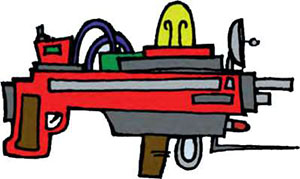
Setup
Divide the cards into the Door deck and the Treasure deck. Shuffle both decks. Deal four cards from each deck to each
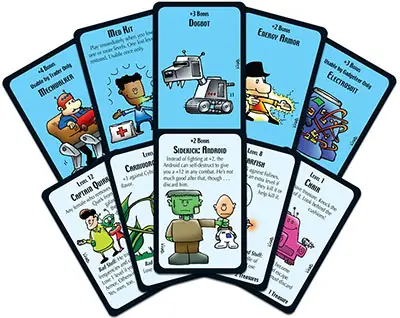
Card Management
Keep separate face-up discard piles for the two decks. You may not look through the discards unless you play a card that allows you to. When a deck runs out, reshuffle its discards. If a deck runs out and there are no discards, nobody can draw any of that kind of card!
In Play: These are the cards on the table in front of you, showing your Race and Class (if any) and the Items you are carrying. Continuing Traps and some other cards also stay on the table after you play them. Cards in play are public information and must be visible to the other players.
Your Hand: Cards in your hand are not in play. They don't help you, but they can't be taken away except by cards that specifically affect "your hand". At the end of your turn, you may have no more than five cards in your hand (see Charity, p. 2).
Cards in play may not be returned to your hand - they must be discarded or traded if you want to get rid of them.
Character Creation
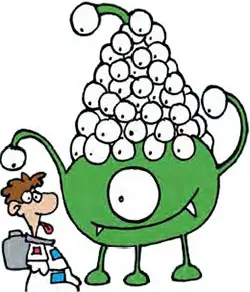
Everyone starts as a Level 1 human with no class. (Heh, heh). Star Munchkin characters are exclusively male or female, and your character's sex is the same as your own unless you declare otherwise.
Look at your initial eight cards. If you have any Race or Class cards, you may (if you like) play one of each type by placing it in front of you. If you have any usable Items (p. 3), you may play them by placing them in front of you.
If you have any doubt about whether you should play a card, you could read these rules, or you could just charge ahead and do it.
Starting and Finishing the Game
Decide who goes first in any agreeable manner. Heh, heh. Play proceeds in turns, each with several phases. When the first player finishes his turn, the player to his left takes a turn, and so on.
Conflicts between Cards and Rules
These rules gives the general rules. Cards may add special rules, so in most cases when the rulesheet disagrees with a card, follow the card.
However, ignore any card effect that might seem to contradict one of the rules listed below unless the card explicitly says it supersedes that rule!
Nothing can reduce a player below Level 1, although card effects might reduce a player's or a monster's combat strength below 1.
You go up a level after combat only if you kill a monster.
You cannot collect rewards for defeating a monster (e.g., Treasure, levels) in the middle of a combat. You must finish the fight before gaining any rewards.
You must kill a monster to reach Level 10.
When you may take Actions
You may perform these actions at any time:
- Discard a Class or Race.
- Play a Go Up a Level or Sidekick.
- Play a Trap.
You may perform these actions at any time, as long as you are not in combat:
- Trade an Item with another player (the other player may not be in combat, either).
- Change which Items you have equipped.
- Play a card that you have just received (some cards may be played even during combat).
You may perform these actions on your own turn:
- Play a new Class or Race card (at any time).
- Sell Items for levels (except when you are in combat).
- Play an Item (most Items cannot be played during combat, but some one-shot Items can; see p. 3).
Combat: Basic Rules
When you fight a monster, you compare your combat strength (your Level plus any bonuses or penalties) against the monster's combat strength.
If your combat strength is greater, you win! If it is tied or lower, the monster wins.
The first player to reach Level 10 wins . . . but you must reach Level 10 by killing a monster, unless a card specifi cally allows you to win another ways.
Turn Phases
Your turn begins as soon as the previous player's turn ends. At the start of your turn, you may play cards, switch Items from "equipped" to "unequipped" or vice versa, trade Items with other players, and sell Items for levels. When your cards are arranged the way you want, go to phase 1.
-
Kick Open the Door
Draw one card from the Door deck and turn it face up. If it's a monster, you must fight it. If the card is a trap, it applies to you immediately (if it can) and is discarded (unless it has a persistent effect or you keep the card as a reminder of an upcoming effect).
If you draw any other card, you may either put it in your hand or play it immediately.
-
Look for Trouble/Loot the Room
If you fought a monster in phase 1, skip this phase and go to phase 3. If you did NOT draw a monster when you first opened the door, you have two choices: either Look For Trouble or Loot The Room.
Look For Trouble: Play a monster from your hand and fight it, just as if you had found it when you kicked open the door. Don't play a monster you can't handle, unless you're sure you can count on getting help.
Loot The Room: Draw a second card from the Door deck, face down, and place it in your hand.
-
Charity
If you have more than five cards in your hand, you must play enough cards to get you to five or below. If you cannot, or do not want to, you must give the excess to the player with the lowest Level.
If players are tied for lowest, divide the cards as evenly as possible, but it's up to you who gets the bigger set(s) of leftovers. If YOU are the lowest or tied for lowest, just discard the excess.
As soon as you are finished with Charity, the next player's turn begins.
Character Stats
Each character is basically a collection of weapons, armor, and magic items, with three stats: Level, Race, and Class. For instance, you might describe your character as "a Level 9 Feline Bounty Hunter with Battle Armor, Diamondoid Teeth, and a Laser-Maser-Dazer".
Level: This is a measure of how generally buff and studly you are. When the rules or cards refer to your Level, capitalized, they mean this number.
You gain a level when you kill a monster, or when a card says that you do. You can also sell Items to buy levels (see Items).
You lose a level when a card says that you do. Your Level can never go below 1. However, your combat strength can be negative if you get hit with a Trap or have some other kind of penalty.
Class: Characters may be Gadgeteers, Psychics, Traders, or Bounty Hunters. If you have no Class card in front of you, you have no class.
Each Class has special abilities, shown on the cards. You gain the abilities of a Class the moment you play its card in front of you, and lose them as soon as you discard that card. Some Class abilities are powered by discards.
Unless the card specifies, you may discard any card, in play or in your hand, to power a special ability. See the Class cards for when abilities can be used.
You can discard a Class card at any time, even in combat: "I don't wanna be a Gadgeteer anymore". When you discard a Class card, you become classless until you play another Class card.
You may not belong to more than one class at once unless you play the Super Munchkin card.
Race: Characters may be Humans, Mutants, Felines, or Cyborgs. If you have no Race card in front of you, you are human. Humans have no special abilities. The rules for Classes, above, also apply to Races. You may not belong to more than one race at once unless you play the Half-Breed card.
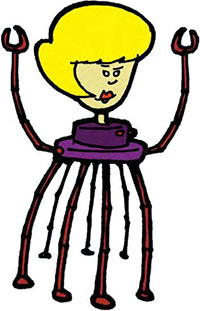
Super Munchkin and Half-breed
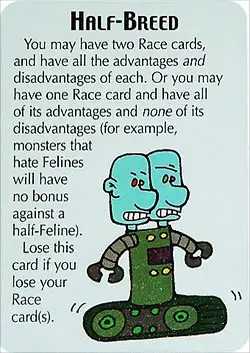
These cards may be played whenever it is legal to play a Class or Race, as long as you have an appropriate card (Class for Super Munchkin, Race for Half-Breed) to attach it to. You cannot have more than one of the same Class or Race card in play at once.
If you play Super Munchkin with one Class, you get all of the advantages of being that Class (the ability to equip Class-only Items, monsters with penalties against that Class suffer those penalties) and none of the disadvantages (you can equip Items forbidden to that Class, and monsters do not get bonuses because of your Class).
If the Class has an ability that has a cost, however, you must still pay it - you aren't that Super! (All of the above is also true for Half- Breed, just for Races).
Treasures
Treasure cards include permanent and "one-shot" cards. Any Treasure card may be played to the table as soon as you get it, or at any time on your own turn except during combat (unless the rules below or the card itself says otherwise).
Items
Most Treasures are Items. Items have a Gold Piece value. ("No Value" is equivalent to zero Gold Pieces, and these cards are also Items).
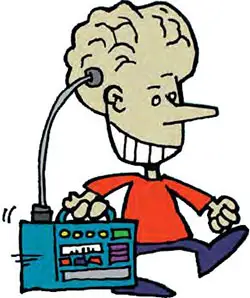
All Items you have in play are considered carried". Items that are actually giving you a bonus are "equipped". You should indicate Items that are not equipped by turning the cards sideways. You may not alter the status of your Items during a combat or while Running Away.
Anyone can carry any Item, but you may equip only one Headgear, one suit of Armor, one pair of Footgear, and two "1 Hand" Items (or one "2 Hands" Item) . . . unless you have a card that lets you ignore those limits, such as Mutant or Cheat!, or unless one of the cards says otherwise. If you are carrying two Headgear cards, for instance (and are not a Mutant), you can equip only one of them at a time.
Likewise, some Items have restrictions: for instance, the Neuronic Whip can only be wielded by a Mutant. Its bonus only counts for someone who is, at the moment, a Mutant.
You cannot discard Item cards "just because". You may sell Items for a level, trade Items with other players, or give an Item to another player who wants it (see Trading). You may discard Items to power certain Class and Race abilities. And a Trap or a monster's Bad Stuff (see p. 5) may force you to get rid of something!
Complex Items: You may carry any number of Complex items, but only equip one, unless you are a Gadgeteer or use a Cheat! card. Any Item not marked Complex is considered Simple.
If something lets you equip more than one Complex item and you lose that ability, you must either correct the problem immediately or unequip all but one Complex item. (If you are in combat at the time, you cannot equip anything else, either!)
Trading: You may trade Items (but no other cards) with other players. You may only trade Items from the table - not from your hand. You may trade at any time except when you or your trading partner are in combat - in fact, the best time to trade is when it's not your turn. Any Item you receive in a trade must remain in play.
You may also give Items away without a trade, to bribe other players - "I'll give you my Bobaser if you won't help Bob fight Great Cthulhu!" You may show your hand to others. Like we could stop you.
Selling Items For Levels: At any point during your turn except during combat or Running Away, you may discard Items worth a total of at least 1,000 Gold Pieces and immediately go up one level. ("No Value" cards are the same as zero Gold Pieces).
If you discard (for instance) 1,100 Gold Pieces worth, you don't get change. But if you can manage 2,000 worth, you can go up two levels at once, and so on. You may sell Items from your hand as well as those you are carrying. You may not sell Items to go to Level 10.
Laser Weapons
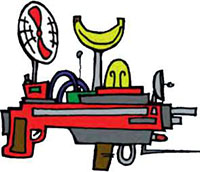
Laser weapons include any Item with a name ending, more or less, in "-aser".
Each laser weapon is a 2-Handed weapon, but any and all laser barrels can be snapped together to create a single 2-Handed weapon with the power of both.
For instance, a Laser (+2) and a Dazer (+3) combine to create a Laser- Dazer (+5). Add another Laser and it's a Laser-Laser-Dazer (+7). And it's still just a single 2-Handed weapon.
However, the combined weapon can be broken down a piece at a time if necessary, and counts as one Item for each card making it up. You cannot Annihilate or Antimatter the whole weapon . . . just one card!
Similarly, only those laser weapons that say they are Complex count as Complex items, where that matters. (But non-Gadgeteers can snap two or more Complex lasers together and use them both!)
All laser weapons are considered fire/flame weapons.
"One-Shot" Treasures
A Treasure card that says "Usable once only" is often called a "one-shot" Treasure. Most of these are used during combat to strengthen the munchkins or the monsters, and may be played from your hand or from the table.
Some have other effects, however, so read the card carefully! Discard these cards as soon as the combat is over or their effect is resolved.
Other Treasures
Other Treasure cards (like Go Up a Level cards) are not Items. Most of these cards say when they can be played, and whether they stay in play or are discarded. Go Up a Level cards may be played on yourself or any other player at any time, even during combat.
Exception: You cannot play a Go Up a Level card to give a player the winning level!
Combat
To fight a monster, compare its combat strength to yours. Combat strength is the total of Level plus all modifiers - positive or negative - given by Items and other cards. If the monster's combat strength is equal to yours, or greater, you lose the combat and must Run Away.
If your combat strength totals more than the monster's - note that monsters win ties! - you kill it and go up a level (two levels for some big monsters). You'll also get the number of Treasures shown on its card.
Sometimes a card will let you get rid of the monster without killing it. This is still "winning", but you don't get a level. Unless the card says otherwise, you don't get the Treasures, either.
Some monster cards have special powers that affect combat - a bonus against a Race or Class, for instance. Be sure to check these!
You and the other players may play one-shot Treasures or use Class or Race abilities to help or harm you in your combat. Some Door cards may also be played into a combat, such as Monster Enhancers (see below).
Remember: while you are in combat, you cannot sell, equip, unequip, or trade Items, or play Treasures from your hand, unless these rules or the card says otherwise.
If you kill a monster (or monsters!), discard the monster(s) and any other cards played, and claim your rewards. But note: someone may play a hostile card on you, or use a special power, just as you think you have won.
When you kill a monster, you must wait a reasonable time, defined as about 2.6 seconds, for anyone else to speak up. After that, you have really killed the monster, and you really get the level(s) and Treasures, though they can still whine and argue.
Monsters
If drawn face-up, during the Kick Open The Door phase, they immediately attack the person who drew them.
If acquired any other way, they go into your hand and may be played during your own turn to Look For Trouble, or played to join another player's fight with the Wandering Monster card. (See Fighting Multiple Monsters).
Each Monster card is a single monster, even if the name on the card is plural.
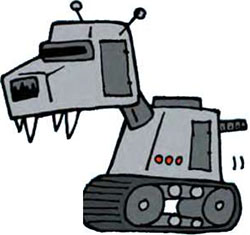
Monster Enhancers
Certain cards, called Monster Enhancers, raise or lower the combat strength of individual monsters. (Penalties to monsters are still considered Enhancers). They also affect the number of Treasures the monsters are worth. Monster Enhancers may be played by any player during any combat.
All enhancers on a single monster add together. If there are multiple monsters in a combat, the person who plays each enhancer must choose which monster it applies to.
Exception: Anything that enhances a monster also enhances its Clone . . . if Radioactive, . . . From Another Dimension, and . . . And Its Clone are played on a single monster, in any order, you are facing a Radioactive monster
Dimension and its Radioactive Clone From Another Dimension. Good luck . ..
Fighting Multiple Monsters
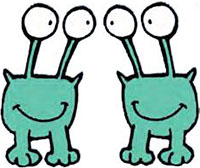
Some cards (notably Wandering Monster) allow your rivals to send other monsters to join the fight. You must defeat their combined combat strengths. Any special abilities, such as fighting with your Level only, apply to the entire fight.
If you have the right cards, you can eliminate one monster from the combat and fight the other(s) normally, but you cannot choose to fight one and run from the other(s).
If you eliminate one monster, but then run from the other(s), you don't get any levels or Treasure!
Undead Monsters
Several monsters in this set are tagged Undead. You may play any Undead monster from your hand into combat to help any other Undead, without using a Wandering Monster card.
If you have a card that can be used to make a monster Undead, you may play it with a non-Undead monster to use this rule.
Interfering With Combat
You can interfere with others' combats in several ways:
Use a one-shot Item. You could help another player by throwing a grenade at his foe. Of course, you can "accidentally" hit your friend with the grenade, and it will count against him.
Play a Monster Enhancer. These cards (usually) make a monster stronger . . . and give it more Treasure. You can play these either during your own combats or during someone else's combat.
Add a monster from your hand to join the combat, either with a Wandering Monster card or by using the special Undead rule.
Trap them, if you have a Trap card.
Asking for Help
If you cannot win a combat on your own, you may ask any other player to help you. If he refuses, you may ask another player, and so on, until they all turn you down or someone helps. Only one player can help you, adding his combat strength to yours. Anyone can play cards to affect your combat, however!
You'll probably have to bribe someone to help. You may offer your helper any Item(s) you are currently carrying, or any number of the Treasure cards the monster has. If you offer him part of the monster's Treasure, you must agree whether he picks first, or you pick first, or whatever.
You may also offer to play any cards from your hand that you legally could, such as Go Up a Level cards, on your helper.
The special abilities or vulnerabilities of the monster also apply to your helper, and vice versa. For instance, if you are not a Feline yourself, and a Feline helps you against a Starfish, the monster is -5 against you. But if you are facing the Fanged Fuzzball and a Feline helps you, the monster's combat strength is increased by 2.
If someone successfully helps you kill the monster, discard it, draw Treasures (see Rewards, p. 5), and follow any special instructions on the monster card. You go up a level for each
slain monster. Your helper does not go up. You draw the Treasure cards, even if it was your helper's special ability that defeated the monster, and distribute them according to the agreement reached.
Rewards
When you kill a monster, you get one level per monster, unless the Monster card says something else, and you get all its Treasure! Each monster has a Treasure number on the bottom of its card.
Draw that many treasures, modified by any Monster Enhancers played on it. Draw face-down if you killed the monster alone. Draw face-up, so the whole party can see what you got, if someone helped you. If you defeat a monster by nonlethal means, you do not get a level and you may or may not get the Treasure, depending on the method.
Treasure cards can be played as soon as you get them, even if you are the helper.
Running Away
If nobody will help you . . . or if somebody tries to help, and your fellow party members interfere so the two of you still cannot win . . . you must Run Away. You
don't get any levels or treasure. You don't even get to Loot The Room. And you don't always escape unharmed . ..
Roll the die. You escape on a 5 or more. Some Class and Race abilities and some Treasures make it easier or harder to Run Away from all monsters. And some monsters give you a bonus or penalty to your roll for that monster only.
If you fail to Run Away from a monster, it does Bad Stuff to you, as described on its card. This may vary from losing an Item, to losing one or more levels, to Death.
If you are fleeing from multiple monsters, you roll separately to escape each one, in any order you choose, and suffer Bad Stuff from each one that catches you as soon as it catches you.
If two players are cooperating and still can't defeat the monster(s), they must both flee. They roll separately, and each player chooses in what order to Run Away. The monster(s) CAN catch them both.
Once you have resolved all Run Away rolls, discard the monster(s).
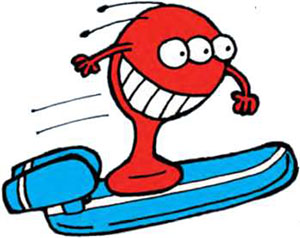
Death
If you die, you lose all your stuff. You keep your Class(es), Race(s), and Level (and any Traps that were affecting you when you died) - your
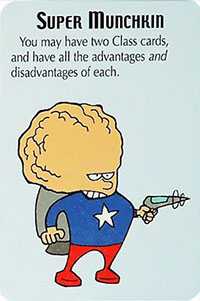
new character will look just like your old one. If you have Super Munchkin or Half-Breed, keep those as well. Once you have died, you don't have to run from any remaining monsters.
Looting The Body: Lay out your hand beside the cards you had in play (making sure not to include the cards mentioned above). If you have an Item carried by a Sidekick or attached to a Cheat! card, separate those cards.
Starting with the player with the highest Level, everyone else chooses one card . . . in case of ties in level, roll a die. If your corpse runs out of cards, tough. Once everyone gets one card, discard the rest. Looted cards go into players' hands.
Dead characters cannot receive cards for any reason, not even Charity, and cannot level up or win the game.
When the next player begins his turn, your new character appears and can help others in combat with his Level and Class or Race abilities . . . but you have no cards, unless you receive Charity or gifts from other players.
On your next turn, start by drawing four cards from each deck, face-down, and playing any Race, Class, or Item cards you want to, just as when you started the game. Then take your turn normally.
Traps
If drawn face-up during the Kick Open The Door phase, Trap cards apply to the person who drew them.
If acquired some other way, such as by Looting The Room, Trap cards go into your hand and may be played on ANY player at ANY time. Any time, do you hear me? Reducing someone's abilities just as he thinks he has killed a monster is a lot of fun.
Usually, a Trap affects its victim immediately (if it can) and is discarded. However, some Traps give a penalty later in the game or have a continuing effect.
Keep these cards until you get rid of the Trap or the penalty takes effect. (Trap cards you keep as a reminder may not be discarded to power Class or Race abilities. Nice try!)
Note: If someone plays a "your next combat" Trap on you while you are in combat, it counts in that combat!
If a Trap can apply to more than one item, the victim decides which item is lost or trapped.
If a Trap applies to something you don't have, ignore it. For instance, if you draw Lose Your Armor and you have no Armor, nothing happens; discard the card.
There will be times when it will help you to play a Trap or Monster on yourself, or to "help" another player in a way that costs him treasure. This is very munchkinly. Do it.
Sidekicks
If you draw a Sidekick, either face up or face down, you may use it immediately or keep it in your hand for later. You may play it at any time, even in combat, as long as you have only one Sidekick in play at a time (two for Traders). You may discard Sidekicks at any time. You may not trade Sidekicks.
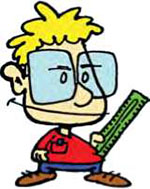
Each Sidekick has certain powers that can help you. They cannot do anything not stated on the card; for instance, they can't carry things unless the card says they can.
A Sidekick is NOT an Item! Sidekicks don't affect a Psychic's bonus for fighting alone. A Sidekick can sacrifice himself for you (indeed, this is the only thing Red Shirts are good for). If you lose a fight, then instead of rolling to run away, you may discard one Sidekick and anything
it is carrying. You automatically escape from all monsters in the fight, even if a monster card says escape is impossible. If someone was helping you in the fight, YOU decide whether that person automatically escapes as well, or must roll to escape.
Continue Reading


